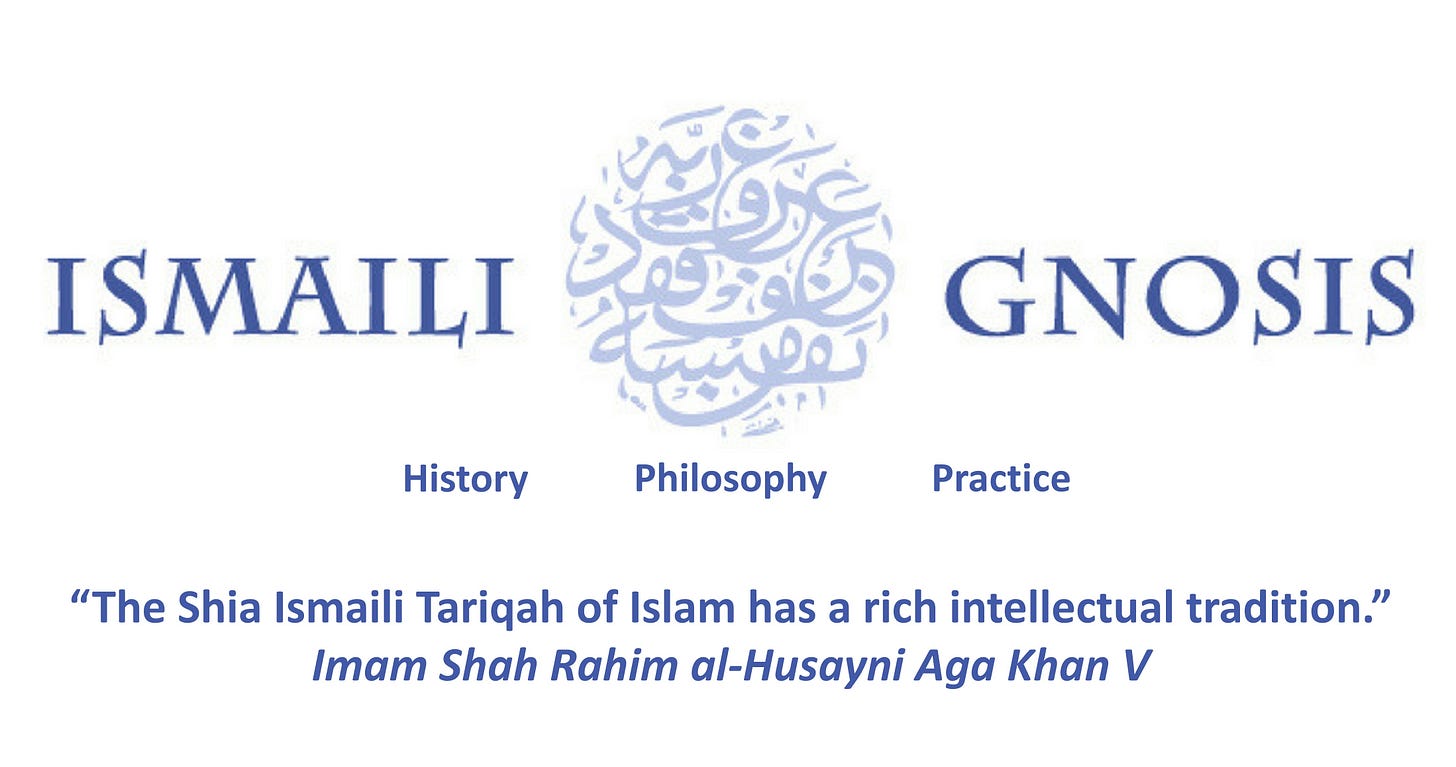Ismaili Eid Namaz: Its Spiritual Meaning (Digest)
A short (5 minute) explanation of the Ta'wil of the Ismaili Eid Namaz
The following is a digest version of our longer comprehensive article on the new ʿId Namaz and its esoteric meaning. For primary source citations, see the original article.
Esoteric Depth of the New Ismaili ʿId Namaz
Ismaili tradition has always stressed that the outer form of worship matters only when its inner purpose is grasped. Imam Sultan Muhammad Shah put it plainly in Zanzibar in 1899: “If one does not perform the esoteric (bāṭinī) practice, then what is the use of namāz, fasting and other outer practices? They are of no use at all.”
With that principle in mind, Ismailis worldwide have just adopted a revised ʿId Namaz authorized by the present Imam. Besides a few textual updates, its most striking feature is how deliberately it invites worshippers to bring the taʾwīl—the hidden, symbolic meaning—into every movement and word.
1 | The Ismaili Neoplatonic Map of Reality
Ismaili philosophy envisions a tiered Neoplatonic schema of reality. Above all creation stands God, utterly beyond name or attribute. The highest created being is the Universal Intellect (al-ʿAql al-Kull), which contains every perfection and therefore lacks nothing. From it emanates the Universal Soul (al-Nafs al-Kullī); yearning for the Intellect’s plenitude, the Soul engenders the remaining spiritual and material worlds—including every human soul. Ismailis today designated these two cosmic realities as the Light of Imamat (nūr al-imāmah) and the Light of Prophethood (nūr al-nubuwwah) and the “metacosmic parents” of the universe. The purpose of religion is for the human soul, microcosm of the Universal Soul, to reunite with its source through disciplined practice and understanding of inner meaning of religion.
2 | The Intention (Niyyah): Two Qiblahs, One Focus
Before the prayer proper the worshipper silently states: I intend to offer two rakʿahs of ʿId al-Aḍḥā namāz, facing the noble Kaʿbah, in recognition (ʿala maʿrifati) of the Proof of the Command, the Lord of the Age, our living Imām, Mawlānā Shāh Raḥīm al-Ḥusayni, and in obedience to him. The sentence enshrines the Shiʿi Ismaili rule that worship is valid only when consciously directed toward the Imām. Outwardly the body faces the Ka‘bah in Mecca; inwardly the soul faces the Imām—the true House of God and esoteric qiblah of human spirits. By placing both orientations in a single intention, the niyyah reminds the believer that ẓāhir and bāṭin, form and meaning, must work together.
3 | Takbīr and Qiyām: Renewing the Covenant
The first gesture is the takbīr: the prayer leader raises both hands to the ears while proclaiming Allāhu Akbar (God is greater). Nasir-i Khusraw teaches that this reenacts the mithāq, the covenant by which every Ismaili pledges allegiance to the Imām. The right hand, symbolizing the five spiritual ranks (Intellect, Soul, Seraphiel, Michael, Gabriel), and the left hand, symbolizing the five physical-religious ranks (Prophet, Founder, Imām, Bāb, Ḥujjah), testify together that God surpasses the entire ten-fold hierarchy of creation. Standing upright (qiyām) afterward embodies steadfastness in that pledge, while the forthcoming Qurʾānic recitations represent the spread of esoteric knowledge along those ranks.
4 | Why Sūrat al-Fātiḥah plus One More?
Seven verses of al-Fātiḥah point to the seven Imāms who appear in every prophetic cycle. The additional sūrah points to their deputies, the Hujjahs. Revelation is therefore two-fold: scripture paired with interpreter, exoteric law paired with esoteric wisdom, Prophet paired with Imām.
5 | Sūrat al-Shams: Attesting the Ranks of Religion
The new Namaz now includes Sūrat al-Shams—“By the Sun and its brilliance, and the Moon when she follows it…”. Ismaili taʾwīl layers three esoteric readings of these celestial symbols:
Cosmic: Sun = Universal Intellect; Moon = Universal Soul; Night = Speaker-Prophet who veils knowledge; Day = Founder who unveils it.
Historical: Sun = Prophet Muḥammad; Moon = Imām ʿAlī, his Legatee, who reflects and elucidates revelation.
Contemporary: Sun = Imām of the Time; Moon = his Bāb or Supreme Ḥujjah (Pir) who channels his light to the community.
The visible heavens thus become a parable of divine guidance: just as lunar light derives from the sun, spiritual illumination flows from the Imām through appointed deputies to every seeker.
6 | Bowing (Rukūʿ): Homage to the Universal Soul
Moving from standing to bowing, the worshipper repeats Allāhu Akbar, admitting that even the four loftiest created ranks—Intellect, Soul, Speaker-Prophet and Founder—cannot encompass God. While bowed he recites Subḥāna Rabbi l-ʿAẓīm (“Glory be to my Sublime Lord”). Nasir-i Khusraw reads rabbi l-ʿaẓīm as the Universal Soul, the cosmic craftsman who builds the universe under the Intellect’s guidance. Bowing therefore expresses deep respect, yet it is less radical a self-surrender than prostration—mirroring the Soul’s noble but secondary status beneath the Intellect.
7 | Rising: The Praise that God Hears
Upon rising the congregation proclaims Samiʿa ’Llāhu li-man ḥamidah, rabbana laka l-ḥamd—God hears the one who praises Him; to You belongs the Praise. The word al-ḥamd is spelled with five letters (Alif, Lām, Hā, Mīm, Dāl), encoding yet again the five spiritual mediators. Genuine praise, the formula teaches, reaches God through recognizing these ranks, above all the Universal Intellect.
8 | Prostration (Sujūd): Unification with the Intellect
Full prostration places the believer’s forehead on the earth, symbol of the Universal Soul that nourishes all bodies. Yet the spoken formula, Subḥāna Rabbi l-Aʿlā (“Glory be to my Exalted Lord”), focuses attention on the superior Universal Intellect. The choreography thus maps the soul’s ascent: it humbles itself within the Soul so that, through that mediation, it may rise toward the Intellect—while never confusing either rank with the utterly transcendent Creator.
9 | Invoking Allāhumma: Five Letters, Five Lights
Several supplications begin with Allāhumma. Its five Arabic letters again symbolise the Intellect, Soul and the three arch-angelic emanations (Seraphiel, Michael, Gabriel). To utter the word is to approach God through the very conduits He has established, acknowledging that all blessing descends through this ordered hierarchy.
10 | After the Salām: Peace from God through Communion with the Imams
The formal Namāz ends with the salām, but the congregation remains for two brief prayers drawn from the Ismaili Duʿā’ . The Prayer of Peace affirms communal harmony, while the Prayer of Communion (taqarrub), drawn from al-Qāḍī al-Nuʿmān’s Daʿāʾim al-Islām, seeks nearness to God “by the grace of Muḥammad … and every Imām up to the Imām of the Time.” The prayer cycle thus closes as it began—rooted in the Imām’s living presence and the cosmic hierarchy he personifies.
The Namāz at a Single Glance
The updated ʿId Namāz is, in effect, a moving diagram of creation and return. Takbīr proclaims God’s transcendence; standing enacts fidelity to the covenant; recitation recalls living teachers; bowing honours the Universal Soul; prostration is oriented towards the Universal Intellect; and the closing supplications reaffirm the Imām’s mediating role. Performed with taʾwīl in mind, every motion becomes a lesson in who we are, where we come from and where we are going—back through the Soul to the Intellect and, beyond all symbol, to the One who is greater than all comparison.
Support Ismaili Gnosis in Publishing New Articles
IN CASE YOU MISSED IT
Where is Imamat Found in the Qur’an?
“We are, and will continue to seek out knowledge and understanding, particularly, from the Qur’an, so that my murids can look forward to the future with interpretation which is correct… and it is important that, as time evolves, we should continue under the guidance of the Imam to seek clarity and understanding from the







